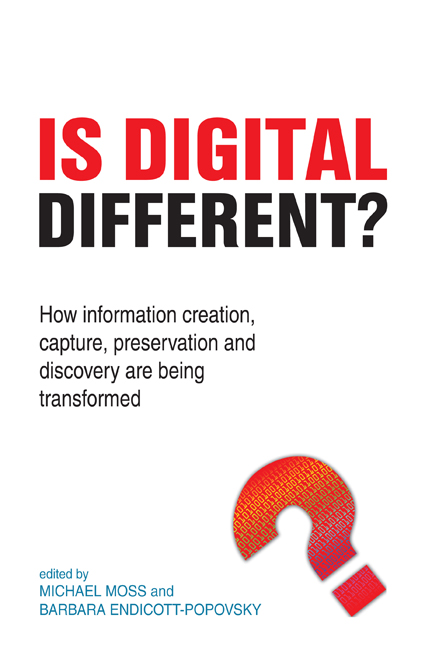 Is Digital Different?
Is Digital Different? Book contents
- Frontmatter
- Contents
- Contributors
- Introduction and acknowledgements
- 1 What is the same and what is different
- 2 Finding stuff
- 3 RDF, the Semantic Web, Jordan, Jordan and Jordan
- 4 Crowdsourcing
- 5 Pathways to integrating technical, legal and economic considerations in the design, development and deployment of trusted IM systems
- 6 Finding archived records in a digital age
- 7 Security: managing online risk
- 8 Rights and the commons: navigating the boundary between public and private knowledge spaces
- 9 From the Library of Alexandria to the Google Campus: has the digital changed the way we do research?
- Index
3 - RDF, the Semantic Web, Jordan, Jordan and Jordan
Published online by Cambridge University Press: 08 June 2018
- Frontmatter
- Contents
- Contributors
- Introduction and acknowledgements
- 1 What is the same and what is different
- 2 Finding stuff
- 3 RDF, the Semantic Web, Jordan, Jordan and Jordan
- 4 Crowdsourcing
- 5 Pathways to integrating technical, legal and economic considerations in the design, development and deployment of trusted IM systems
- 6 Finding archived records in a digital age
- 7 Security: managing online risk
- 8 Rights and the commons: navigating the boundary between public and private knowledge spaces
- 9 From the Library of Alexandria to the Google Campus: has the digital changed the way we do research?
- Index
Summary
This chapter is about the key novelties of the Semantic Web – the novel ideas, and the novel opportunities. But we will discuss these digital novelties in the context of the Semantic Web's continuities with other features of the information world.
Our most obvious antecedent is not that old – the (non-semantic) web didn't exist before the 1990s – and we will learn about the very close technical overlap between the Semantic Web and the ‘textual web’ of our now-usual experience. The Semantic Web is – closer than a cousin – the sibling of the textual web.
Other antecedents have a history as old as the first library index. The Semantic Web has, we might say, a ‘logical wing’ and an ‘information wing’. These are primarily distinguished not by their technical or organizational features but by the largely disjoint research questions they address, and by their motivations. While the ‘logical wing’ is characterized by a concern for formal logic and its implementations, rich in the theory of computing science,1 the ‘information wing’, with a sturdily pragmatic focus, can be regarded as continuous with the information-organizing goals of the world of library science, sharing its aspiration to systematize and share information and its acknowledgement that such sharing is always approximate and never unmediated and that one must aim for a balance between faithfulness to sources and what is actually usable by the information's actual audience.
Below, we will start with a broad introduction to the Semantic Web. From there we can move briskly on to practice and the question of where, how and whether the Semantic Web might appear in technological fact. Our goal is to indicate the continuities with the textual web and thus to indicate the novelties of the Semantic Web, and so to suggest why they are important. After a brief parenthesis on ‘Web 2.0’, we describe ‘linked data’.
What is the Semantic Web?
The Semantic Web is simple, in summary:
The Semantic Web is the emerging next stage of the web, designed to transmit machine-processable meaning, through a logical framework named RDF [Resource Description Framework], enhanced by machine inference based on OWL [Web Ontology Language] and other ontologies.
- Type
- Chapter
- Information
- Is Digital Different?How information creation, capture, preservation and discovery are being transformed, pp. 35 - 70Publisher: FacetPrint publication year: 2015


